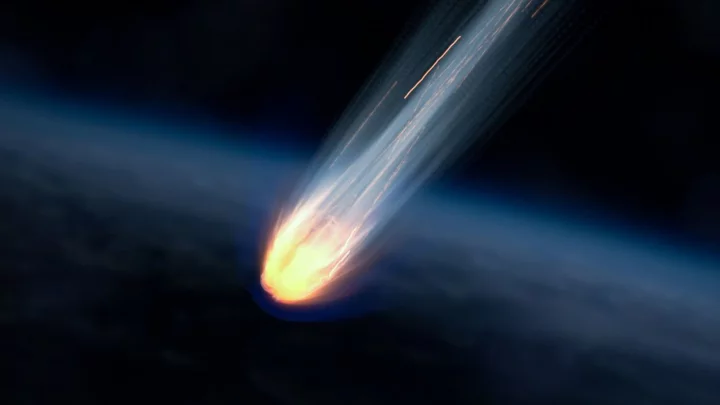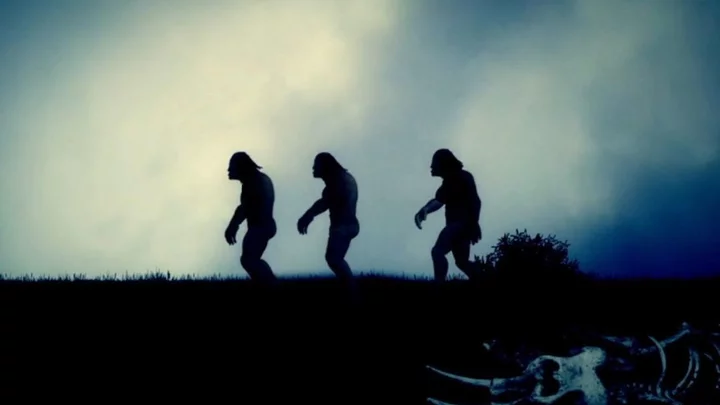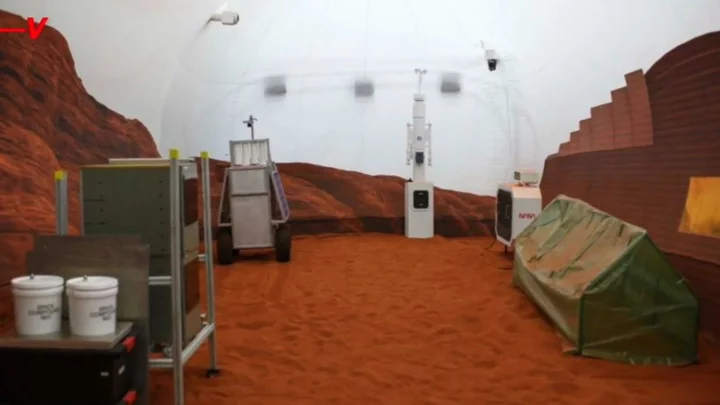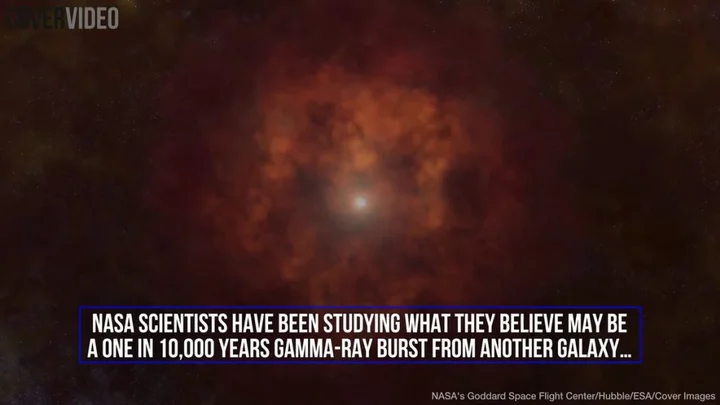
Meituan Joins AI Race by Buying Co-Founder’s Months-Old Firm
Meituan is buying a co-founder’s generative AI startup for almost $234 million, a deal that gets the food-delivery
2023-06-30 08:45

'Alien spacecraft' found at the bottom of Pacific Ocean
For years people have been looking to the skies for signs of alien life - but maybe, they should have been looking at the bottom of the ocean this whole time. A Harvard physicist has claimed that parts of an alien 'spacecraft' could have been uncovered under the sea. Professor Avi Loeb set off on a search along the bottom of the Pacific Ocean and found 50 iron pieces which originated from the IM1 meteor. IM1 crashed off the coast of Papua New Guinea and Leob believes it could contain key information in the search for life out there in the universe, saying he hasn’t discounted the idea of the pieces being evidence of a “spacecraft” from an “extraterrestrial technological civilization” which crashlanded on Earth. Sign up to our free Indy100 weekly newsletter Loeb is currently the head of Harvard’s Galileo Project, focusing on the search for aliens, and he said the fragments they found must have come from “a natural environment different from the solar system, or an extraterrestrial technological civilization.” Speaking to Fox News Digital, Loeb detailed his thoughts on the origins of the meteor fragments by saying: “Given IM1's high speed and anomalous material strength, its source must have been a natural environment different from the solar system, or an extraterrestrial technological civilization.” He added that IM1 “is actually tougher and has material strength that is higher than all the space rocks that were catalogued by NASA. That makes it quite unusual.” Have your say in our news democracy. Click the upvote icon at the top of the page to help raise this article through the indy100 rankings.
2023-06-29 21:27

Everybody alive today came from one African country, according to study
It’s well known that all humans alive today can be traced back to a common ancestor but a study may have found where that ancestor originates. Researchers at the University of Oxford’s Big Data Institute mapped the entirety of genetic relationships among humans to create the largest human family tree ever. By combining modern and ancient human genomes data from eight different databases, the researchers were able to create a massive family tree. This allowed them to see how a person’s genetic sequence relates to another using the points of the genome. Sign up for our free Indy100 weekly newsletter “Essentially, we are reconstructing the genomes of our ancestors and using them to form a vast network of relationships,” Lead author Dr Anthony Wilder Wohns said. “We can then estimate when and where these ancestors lived.” Where they lived? Sudan, Africa. Dr Wohns told Reuters, "The very earliest ancestors we identify trace back in time to a geographic location that is in modern Sudan. “These ancestors lived up to and over 1 million years ago—which is much older than current estimates for the age of Homo sapiens—250,000 to 300,000 years ago. So bits of our genome have been inherited from individuals who we wouldn’t recognize as modern humans," Dr Wohns said. Researchers used 3,609 individual genome sequences from 215 populations and samples that ranged from 1,000s to over 100,000 years. By using a new method to compile the data, algorithms were able to predict where common ancestors were in evolutionary trees to explain some patterns of genetic variation. The results were a network of almost 27 million ancestors. “The power of our approach is that it makes very few assumptions about the underlying data and can also include both modern and ancient DNA samples,” Dr Wohns says. Not only does the data help us understand human geology better but the new method could help in other research, like medicine. “The underlying method could have widespread applications in medical research, for instance identifying genetic predictors of disease risk," Dr Wohns added. Have your say in our news democracy. Click the upvote icon at the top of the page to help raise this article through the indy100 rankings.
2023-06-29 18:21

Stephen Hawking theory proved right by man-made black hole
Scientists have managed to simulate their very own black hole in their lab and witnessed how it began to glow. The black hole event horizon was created by a team of physicists from the University of Amsterdam, who used a chain of atoms in a single file to gain further understanding about the behaviour of a black hole. Its creation managed to prove Stephen Hawking's theory from 1974 where the black hole emitted a rare form of radiation. Sign up to our free Indy100 weekly newsletter They studied the properties of Hawking radiation through the creation of a black hole analog in the lab. According to Science Alert, Hawking radiation happens when "particles born from disturbances in the quantum fluctuations caused by the black hole's break in spacetime." The fact that the radiation exhibits a glow itself is in a strange space anomaly, as the event horizon of a black hole is supposed to be where neither light nor matter is able to get out. We all learn about the strength of a black hole in science class – and how we would all be inevitably sucked in as a result. This is possible due to its density within a certain range of the centre, so even an attempt at travelling beyond light speed (or any velocity in the universe for the matter) would not make this unavoidable. The fake black hole event also caused a rise in temperature that matched theoretical expectations of an equivalent black hole system, - but only when part of the chain extended beyond the event horizon, Science Alert reported. As a result, it is believed perhaps this entanglement of particles that straddle the event horizon plays a big role in generating Hawking radiation. Under simulations that began by mimicking spacetime thought of as "flat," scientists say the radiation was only thermal for a certain range of 'hop amplitudes'. So there may be certain situations where Hawking radiation can emit thermally - and could only be the case where gravity causes a change in the warp of space-time. "This can open a venue for exploring fundamental quantum-mechanical aspects alongside gravity and curved spacetimes in various condensed matter settings," the scientists wrote in their paper published by Physical Review Research. Have your say in our news democracy. Click the upvote icon at the top of the page to help raise this article through the indy100 rankings
2023-06-29 18:19

Scientists discover gigantic 'structure' under the surface of the Moon
The Moon has been a subject of awe and fascination for millennia, with its shape-shifting powers and enigmatic dark side. And though it’s the one celestial body on which man has taken (small) steps, we still have big leaps to go in understanding its potential and uncovering its secrets. However, one hidden feature of the Moon has been unearthed by scientists and it’s very, very big, and very, very heavy. Buried beneath its South Pole-Aitken basin – one of the largest preserved craters in the Solar System – is a structure which weighs at least 2.18 billion kilogrammes and measures more than 300km (186 miles) in depth and 2,000km (1,243 miles) in length. Sign up for our free Indy100 weekly newsletter The researchers who made the discovery, all based in the US, posited that the “anomaly” could be made out of metal from the core of an asteroid or oxides from the crystallisation of a magma ocean. "One of the explanations of this extra mass is that the metal from the asteroid that formed this crater is still embedded in the Moon's mantle,” lead author Peter B. James, from Houston’s Baylor University, said in a statement shared with IFLScience. Illustrating just how gigantic this thing is, he went on: "Imagine taking a pile of metal five times larger than the Big Island of Hawaii and burying it underground. That's roughly how much unexpected mass we detected.” The groundbreaking finding was made thanks to NASA’s Gravity Recovery and Interior Laboratory (GRAIL) mission, which measures changes in the Moon’s gravitational field. Data collected by GRAIL can then be used to study the internal composition of our cratered companion. The South Pole-Aitken Basin has been at the centre of numerous investigations because of just how unique it is. The region offers clues both on the interior composition of our closest satellite and its history, and who knows what other mysteries it holds... Have your say in our news democracy. Click the upvote icon at the top of the page to help raise this article through the indy100 rankings.
2023-06-29 17:54

Titan Submersible Disaster Probes Face Tricky Test of Criminal Liability
US and Canadian officials are looking into what went wrong in a commercial deep-sea adventure and whether crimes
2023-06-29 05:17

Four Nasa volunteers are living on 'virtual Mars' for the next 12 months
Would you sign up to live in isolation for a year, all in the name of furthering scientific research? Probably not, we’re guessing, but that’s exactly what four NASA volunteers have agreed to do over the next 12 months. The participants will live in an environment created to simulate conditions on the surface of Mars as part of NASA's Crew Health and Performance Exploration Analog for 378 days. The people involved are research scientist Kelly Haston, structural engineer Ross Brockwell, emergency medicine physician Nathan Jones and US Navy microbiologist Anca Selariu. Sign up to our free Indy100 weekly newsletter The simulation has been built at the Johnson Space Center in Houston, Texas, and will see the four volunteers undertake a series of tasks as part of the exercise. Data collected over the next 12 months will help to inform future missions to send astronauts to Mars. During that time, the guests will take part in activities such as crop growing as well as simulated spacewalks and other operations. The 3D-printed hub they’ll spend their time in contains a kitchen, sleeping areas, two bathrooms as well as work and recreation spaces. The mission will also see the guests faced with simulated obstacles, which are designed to test responses to equipment failure, communication delays and other issues. Speaking at a recent briefing, the mission's principal investigator at NASA Grace Douglas said: “Thank you all for your dedication to exploration. Our best wishes go with you." Haston also spoke, calling her fellow participants an "amazing group of dedicated individuals who feel very passionate about space exploration and science." "The crew has worked so hard this month to get ready for this mission," Haston added. "It has been very special to be a part of such a tremendous group of scientists and specialists from a diverse set of backgrounds working together to bring CHAPEA 1, the first of three missions, to reality." Have your say in our news democracy. Click the upvote icon at the top of the page to help raise this article through the indy100 rankings.
2023-06-28 21:54

‘Dome of Doom’ Scorching Texas and Mexico Is About to Spread (1)
The heat that has set records across Texas and Mexico will be spreading across the central and southern
2023-06-28 21:18

Eli Lilly’s Experimental Weight-Loss Shot Gives Company’s Strongest Results Yet
An experimental weight-loss shot from Eli Lilly & Co. yielded the strongest results of any of its treatments
2023-06-27 05:28

Astronomers discover a totally new way that stars can die
Astronomers have discovered a new way that stars can die. In a study published in the journal Nature Astronomy, experts have worked out that a minute-long gamma-ray burst of light, which occured in 2019 and evidence a star dying, happened because stars collided within the densely crowded environment near the supermassive black hole at the centre of an ancient galaxy. Normally gamma-ray bursts (GRB) last around two seconds and happen when stars collapse. “For every hundred events that fit into the traditional classification scheme of gamma-ray bursts, there is at least one oddball that throws us for a loop,” said study coauthor Wen-fai Fong, assistant professor of physics and astronomy at Northwestern University’s Weinberg College of Arts and Sciences, in a statement. “However, it is these oddballs that tell us the most about the spectacular diversity of explosions that the universe is capable of.” Over time, astronomers have observed three main ways that stars can die, depending on their size. Lower mass stars like our sun shed their outer layers as they age, eventually becoming dead white dwarf stars. Sign up to our free Indy100 weekly newsletter Massive stars burn through the fuel-like elements at their core and shatter in explosions called supernovas. Doing so can leave behind dense remnants like neutron stars or result in the creation of black holes. A third form of star death results when neutron stars or black holes begin to orbit one another in a binary system and spiral closer to one another until they collide and explode. But the new observation suggests a fourth type of death. “Our results show that stars can meet their demise in some of the densest regions of the universe, where they can be driven to collide,” said lead study author Andrew Levan, an astrophysics professor at Radboud University in Nijmegen, Netherlands, in a statement. “This is exciting for understanding how stars die and for answering other questions, such as what unexpected sources might create gravitational waves that we could detect on Earth.” “The lack of a supernova accompanying the long GRB 191019A tells us that this burst is not a typical massive star collapse,” said study coauthor Jillian Rastinejad, a doctoral student of astronomy at Northwestern, in a statement. “The location of GRB 191019A, embedded in the nucleus of the host galaxy, teases a predicted but not yet evidenced theory for how gravitational-wave emitting sources might form.” “While this event is the first of its kind to be discovered, it’s possible there are more out there that are hidden by the large amounts of dust close to their galaxies,” said Fong, who is also a member of the Center for Interdisciplinary Exploration and Research in Astrophysics at Northwestern. “Indeed, if this long-duration event came from merging compact objects, it contributes to the growing population of GRBs that defies our traditional classifications.” You learn something new every day. Have your say in our news democracy. Click the upvote icon at the top of the page to help raise this article through the indy100 rankings.
2023-06-26 19:27

Scientists have come up with a new meaning of life – and it's pretty mind-blowing
The meaning of life is the ultimate mystery – why do we exist? And is there a point to… well… anything? These are questions to which we may never find answers, but at least we can define what “life” means in scientific terms. And yet, our understanding of what life is is changing all the time, thanks to space exploration. As scientists continue to hunt for life beyond our own world, biologists are having to rethink the meaning of the word “life” itself. Sign up for our free Indy100 weekly newsletter Generally, biologists explain “life” as connoting a self-sustaining chemical system which is capable of performing functions such as eating, metabolising, excreting, breathing, moving, growing, reproducing, and responding to external stimuli. This definition works pretty well here on Earth (although there are some important exceptions, such as viruses), but experts have pointed out that if life exists elsewhere in the universe, it may not display the same properties that we’re used to. Indeed, it might be unrecognisable as life as we know it (forget those little green men). In which case, how will we spot it if it ever crosses our path? Astrobiologist Sara Imari Walker and chemist Lee Cronin think they’ve come up with a solution. The pair are now arguing that highly complex molecules found in all living creatures can’t exist thanks purely to chance. Therefore, they say, the universe must have a way of creating and reproducing complex information and retaining a “memory” of all of this.. In an interview with New Scientist, Walker, of Arizona State University, explained their radical idea on how objects come into existence. The concept, known as Assembly Theory, explains why certain complex objects have become more abundant than others by considering their histories. If the theory proves correct, it will redefine what we mean by “living” things and show that we’ve been going about the search for extraterrestrial life all wrong. In the process, we could even end up creating alien life in a laboratory, she stressed. In her discussion with New Scientist, Walker pointed out: "An electron can be made anywhere in the universe and has no history. You are also a fundamental object, but with a lot of historical dependency. You might want to cite your age counting back to when you were born, but parts of you are billions of years older. "From this perspective, we should think of ourselves as lineages of propagating information that temporarily finds itself aggregated in an individual." Assembly theory predicts that molecules produced by biological processes must be more complex than those produced by non-biological processes, as Science Alert notes. To test this, Walker and her team analysed a range of organic and inorganic compounds from around the world and outer space, including E. coli bacteria, urine, meteorites and even home-brewed beer. They then smashed up the compounds into smaller pieces and used mass spectrometry to pinpoint their molecular building blocks. They calculated that the smallest number of steps required to reassemble each compound from these building blocks was 15. And whilst some compounds from living systems needed fewer than 15 assembly steps, no inorganic compounds made it above this threshold. "Our system … allows us to search the universe agnostically for evidence of what life does rather than attempting to define what life is," Walker, Cronin, and others wrote in a 2021 Nature Communications article. The handy thing about this building block system – which they’ve dubbed the “'molecular assembly index” – is that it doesn’t rely on carbon-based organic materials to be identified. In other words, an alien could be made of entirely different stuff entirely and we’d still be able to spot it as life using the index. It also works regardless of what stage of “life” an extraterrestrial being is in – whether it is still in its infancy or has moved into a technological stage beyond our understanding. That’s because all of these states produce complex molecules which couldn’t exist in the absence of a living system. If all of this is hurting your head, let’s just get back to the basics: if there is a secret to life, it might all be down to what we do, not what we are. Have your say in our news democracy. Click the upvote icon at the top of the page to help raise this article through the indy100 rankings.
2023-06-25 19:50

Heartbeat sensors on shopping trolleys 'could save lives', new study suggests
New findings have suggested that adding sensors to supermarket trolleys could save people’s lives. Scientists investigated whether installing electrocardiogram (ECG) sensors – designed to check the heart’s rhythm – on the handles of supermarket, trolleys could identify shoppers with atrial fibrillation, which causes an irregular and often abnormally fast heart rate. The sensors would detect heart conditions that put them at increased risk of stroke. The researchers said that over the course of two months, they identified 39 people who were unaware that they had the condition. Ian Jones, professor of cardiovascular nursing at Liverpool John Moores University, who led the study, said: “That’s 39 people at greater risk of stroke who received a cardiologist appointment.” He added: “This study shows the potential of taking health checks to the masses without disrupting daily routines.” It is estimated that around 1.5 million people in the UK have atrial fibrillation, contributing to one in five strokes. The condition is treatable, but at least another 270,000 people in the UK remain undiagnosed and unaware, according to the British Heart Foundation. Sign up for our free Indy100 weekly newsletter There are wearable devices that can also spot irregular heartbeat but this would also require people to take responsibility and wear the device. Professor Jones said: “Nearly two-thirds of the shoppers we approached were happy to use a trolley, and the vast majority of those who declined were in a rush rather than wary of being monitored. “This shows that the concept is acceptable to most people and worth testing in a larger study.” He added: “Checking for atrial fibrillation while people do their regular shopping holds promise for preventing strokes and saving lives. “A crucial aspect is providing immediate access to a health professional who can explain the findings and refer patients on for confirmatory tests and medication if needed.” The findings were presented at ACNAP 2023 conference organised by the European Society of Cardiology (ESC). Have your say in our news democracy. Click the upvote icon at the top of the page to help raise this article through the indy100 rankings.
2023-06-25 16:46
